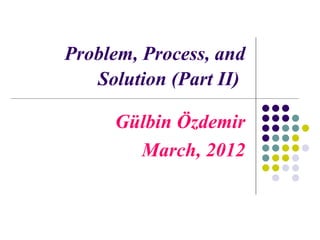Problem process solution_academic_writing
- 1. Problem, Process, and Solution (Part II) Gülbin Ûzdemir March, 2012
- 2. Do you like chocolate cakes?
- 3. Here is the recipe! A. INSTRUCTIONS B. PROCESS First,the oven is preheated. Preheat the oven Then, the dark chocolate is Break the dark broken in pieces. Next, chocolate in pieces some butter is melted with Melt some butter with those pieces of chocolate. those pieces of chocolate After that, some water, Add some water, some some flour, some sugar flour, some sugar and eggs and eggs are added. Ready to bake! ItŌĆÖs ready to bake.
- 4. Academic writing requiresŌĆ” that you use ŌĆśPassive VoiceŌĆÖ rather than giving instructions while writing an academic process description. We shall see what happens and why it does so in the following examples.
- 5. Language Focus: Verbs and Agents in the Solution 1. Imperatives and Passive Voice 2. Flow of Ideas in a Process Description 2.1 Participles 2.2 Active Voice 2.3 Causes and Effects
- 6. 1. Here is a set of instructions about how to prepare a flu vaccine * Identify the three most common strains of flu virus. * Grow each of the strains separately and harvest. * Purify the harvested virus. * Inactivate the purified virus. * Blend the inactivated virus strains together with a carrier fluid and dispense into vials. THIS FORM COULD BE USED AS A GUIDANCE ŌĆśImperatives are usedŌĆÖ
- 7. If you need to write an academic explanation in a process, First, the three most common strains of flu virus are identified. These strains are then separately grown and harvested. The harvested virus is purified and inactivated. Finally, the inactive virus strains are blended together with a carrier fluid and dispensed into vials. ŌĆśPassive Voice is usedŌĆÖ
- 8. When to use ŌĆśAgentsŌĆÖ The technician identifies the virus strains in the lab. The technician separately grows and harvests the virus. The technician purifies and inactivates the virus. The technician blends the inactive virus strains together with a carrier fluid and dispenses them into vials. ŌĆśThe process is backgrounded and the emphasis shifts to the agentŌĆÖ
- 9. Agents could be used, when describing the history of the field. From JuncoŌĆÖs (2011) article titled ŌĆśThe Relationship between frequency of Facebook use, participation in Facebook and student engagementŌĆÖ The study used a 19-item NSSE scale developed by Junco, Heiberger et al. (2010) to measure engagement.
- 10. 2. Flow of Ideas in a Process Description Verbs should very carefully be put together. 2.1 Participles ŌĆśŌĆ”listening skills are ignored.ŌĆÖ Ignored listening skills areŌĆ”.ŌĆÖ 2.2 Active Voice Natural processes stay still. ŌĆśSun risesŌĆ”ŌĆÖ
- 11. 2.3 Causes and Effects
- 12. Language Focus: -ing Clauses of Result To avoid using to much ŌĆśthereforeŌĆÖ and ŌĆśas a resultŌĆÖ, you may use: ŌĆśAny number of the students can take part in a radio play, as a result of modifying the scriptŌĆÖ (Sze, 2006). ŌĆśAny number of the students can take part in a radio play, by modifying the scriptŌĆÖ (Sze, 2006).
- 13. Language Focus: Indirect Questions Indirect questions follow a standard word order. They do not require the subject and verb to be inverted. Direct Question: What time is it? Indirect Question: She asked what time it is.
- 14. Use of Indirect Questions ŌĆśUntil such time, nonnative speakers of English will remain uncertain about how effective their publications are in their own languagesŌĆÖ. ŌĆśBeing able to know about our students individual learning styles and preferences will give us the clue so as to know whether we should correct them or not and how error correction could improve their linguistic and communicative competenceŌĆÖ(Martinez, 2006).
- 15. References Al- Ansari, H., S. 1993. Integrative and Instrumental Motivation as Factors Influencing Attained Levels of Proficiency in English. J. King Saud Univ., Vol 5, Arts (2), pp. 71-83. King, FJ., Goodson, L., Rohani, F. Higher Order Thinking Skills. Retrieved from:http://www.cala.fsu.edu/files/higher_order_thinking_skills. pdf Martinez, S., G. 2006. Should we correct our studentsŌĆÖ errors in L2 learning? Retrieved from: http://www.encuentrojournal.org/textos/16.8.pdf Swales, J., M. and Feak, B., C. 2004. Academic Writing for Graduate Students, Essential Tasks and Skills. The University of Michigan Press.
















